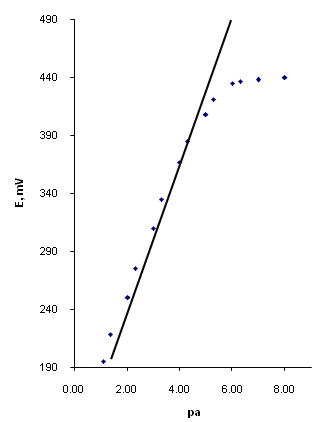Chemistry Journal of Moldova
2008 Volume 3, no.1
Author(s):
Field: Ecological chemistry
Type: Research paper
Issue: 2008 Volume 3, no.1
Pages: 118-126
Maria Gonta, Gheorghe Duca, Diana Porubin
Field: Ecological chemistry
Type: Research paper
Issue: 2008 Volume 3, no.1
Pages: 118-126
Full Text (PDF): Download
DOI: dx.doi.org/10.19261/cjm.2008.03(1).01
Graphical Abstract: This research paper presents the results of the investigation of antioxidant activities of various inhibitors, which are constituents of winery products: quercitin, rezveratrol, dihydroxyfumaric acid. Also, the antioxidant activity of tartaric and dihydroxyfumaric (DFH4) acids derivatives has been determined: sodium dihydroxyfumarate, dimethylic ester of DFH4 and dimethylic ester of tartaric acid. The enotannin extracts obtained from grape seeds have been evaluated: the non-oxidized enotannin extract Eneox and the oxidized one -Enoxil.
Downloads: 48
Author(s):
Field: Analytical chemistry
Type: Research paper
Issue: 2008 Volume 3, no.1
Pages: 52-55
Gheorghe Zgherea
Field: Analytical chemistry
Type: Research paper
Issue: 2008 Volume 3, no.1
Pages: 52-55
Full Text (PDF): Download
DOI: dx.doi.org/10.19261/cjm.2008.03(1).02
Graphical Abstract: Mixtures of small quantities of carbonyl compounds are presents in foods, concerning sensorial qualities. The inferior carbonyl compounds (C2-C4, boiling point <100°C) – mono and dicarbonyl – can be identified and measured their concentrations, after a separation by distillation on the water bath. They are transferred in a strongly acid solution of 2.4-dinitrophenylhidrazine (2.4-DNPH), generating a mixture of insoluble 2.4-dinitrophenylhidrazones (2.4-DNPH-ones). The 2.4-DNPH-ones are organic compounds with weak polarity, solids, crystallized, yellows and water insoluble, soluble in organic solvents. The mixture of 2.4dinitrophenylhidrazones may be separated by liquid chromatography, using the reverse phase mechanism [1-3]. This paper contains experimental and theoretical considerations to the means of separation through liquid chromatography of two synthetically and a natural mixtures that contain 2.4-DNPH-ones provided by inferior carbonyl compounds; to obtain conclude results, in the synthetically mixtures was introduce and 2.4-DNPH-ones provided by carbonyl compounds having three (acetone and propanal) and four (isobutyl aldehyde) atoms of carbon.
Downloads: 23
Author(s):
Field: Analytical chemistry
Type: Research paper
Issue: 2008 Volume 3, no.1
Pages: 48-51
Gheorghe Zgherea
Field: Analytical chemistry
Type: Research paper
Issue: 2008 Volume 3, no.1
Pages: 48-51
Full Text (PDF): Download
DOI: dx.doi.org/10.19261/cjm.2008.03(1).03
Graphical Abstract: An equimolar mixture of 2.4-dinitrophenylhidrazones (2.4DNPH-ones) providing by acetaldehyde and diacetyl must be analyzed
Downloads: 12
Author(s):
Field: Ecological chemistry
Type: Research paper
Issue: 2008 Volume 3, no.1
Pages: 56-61
Georgiana Vasile, Stanescu Bogdan, Tudor Claudia, Elena Mihaila
Field: Ecological chemistry
Type: Research paper
Issue: 2008 Volume 3, no.1
Pages: 56-61
Full Text (PDF): Download
DOI: dx.doi.org/10.19261/cjm.2008.03(1).04
Downloads: 14
Author(s):
Field: Ecological chemistry
Type: Research paper
Issue: 2008 Volume 3, no.1
Pages: 77-84
Rodica A. Sturza, Olga I. Deseatnicov, Cristina M. Popovici, Valentin S. Gudumac, Ion Nastas
Field: Ecological chemistry
Type: Research paper
Issue: 2008 Volume 3, no.1
Pages: 77-84
Full Text (PDF): Download
DOI: dx.doi.org/10.19261/cjm.2008.03(1).05
Graphical Abstract: Iodine deficiency is the most prevalent micronutrient deficiency in the world today. Food fortification is an important compliment to food-based approaches, and iodine fortification of foods as one of the strategies for the control of iodine deficiency. Manufacturing and consumption of sunflower oil fortified with iodine as well as derivative products on it basis is a perspective direction for elimination of alimentary dependent iodine deficiency disorders. The present work examines morphological changes in the thyroid system of rats at the experimental mercatholile-induced hypothyroidism. As well it determines the influence of iodinated oil and margarine on the thyroid system of rats. It specifies the safe value of iodinated oil and margarine for rats. In-vivo study demonstrated the efficacy of fortification of lipid products with iodine under iodine deficiency status.
Downloads: 16
Author(s):
Field: Physical chemistry and chemical physics
Type: Short communication
Issue: 2008 Volume 3, no.1
Pages: 127-128
Natalia Secara
Field: Physical chemistry and chemical physics
Type: Short communication
Issue: 2008 Volume 3, no.1
Pages: 127-128
Full Text (PDF): Download
DOI: dx.doi.org/10.19261/cjm.2008.03(1).06
Graphical Abstract: This short communication presents several preliminary results obtained during kinetic investigation of dihydroxyfumaric acid decarboxylation. The reaction order towards the hydrogen ions concentration has been established, the correlation between the decarboxylation velocity and temperature has been found, the Arrhenius equation for the decarboxylation constant has been drawn.
Downloads: 23
Author(s):
Field: Analytical chemistry
Type: Research paper
Issue: 2008 Volume 3, no.1
Pages: 44-47
Mihail Revenco, Mariana Martin, Waell A.A. Dayyih
Field: Analytical chemistry
Type: Research paper
Issue: 2008 Volume 3, no.1
Pages: 44-47
Full Text (PDF): Download
Abstract (JPEG)
DOI: dx.doi.org/10.19261/cjm.2008.03(1).07
Graphical Abstract: The paper describes the analytical potentialities of the trinuclear chromium(III) complexes as potentiometric ionophores for the construction of electrodes sensitive to the presence of nitrate anion. The electroactive material containing 4,4’-bipyridil was synthesized in situ. The membrane was prepared using dioctylphthalate as a solvent mediator and poly (vinyl chloride) as a polymeric matrix. The electrodes presented a slope of 56 mV/decade, a low limit of detection (3,2.10-6 mol/l), an adequate lifetime (4 months), and suitable selectivity characteristics when compared with other nitrate electrodes. The good parameters of this electrode made possible its application to the determination of nitrate in different types of fertilizers.
Downloads: 13
DOI: dx.doi.org/10.19261/cjm.2008.03(1).07
Graphical Abstract: The paper describes the analytical potentialities of the trinuclear chromium(III) complexes as potentiometric ionophores for the construction of electrodes sensitive to the presence of nitrate anion. The electroactive material containing 4,4’-bipyridil was synthesized in situ. The membrane was prepared using dioctylphthalate as a solvent mediator and poly (vinyl chloride) as a polymeric matrix. The electrodes presented a slope of 56 mV/decade, a low limit of detection (3,2.10-6 mol/l), an adequate lifetime (4 months), and suitable selectivity characteristics when compared with other nitrate electrodes. The good parameters of this electrode made possible its application to the determination of nitrate in different types of fertilizers.
Downloads: 13
Author(s):
Field: Physical chemistry and chemical physics
Type: Research paper
Issue: 2008 Volume 3, no.1
Pages: 112-117
Ivan Ogurtsov, Andrei Tihonovschi
Field: Physical chemistry and chemical physics
Type: Research paper
Issue: 2008 Volume 3, no.1
Pages: 112-117
Full Text (PDF): Download
DOI: dx.doi.org/10.19261/cjm.2008.03(1).08
Graphical Abstract: The ground state was calculated to be a quintet, which means a ferromagnetic interaction between centers. The
Downloads: 13
Author(s):
Field: Ecological chemistry
Type: Research paper
Issue: 2008 Volume 3, no.1
Pages: 62-66
V. M. Mukhin, T. G. Lupascu
Field: Ecological chemistry
Type: Research paper
Issue: 2008 Volume 3, no.1
Pages: 62-66
Full Text (PDF): Download
DOI: dx.doi.org/10.19261/cjm.2008.03(1).09
Graphical Abstract: The authors present a brief analysis of the current global situation concerning the utilization of activated carbon in various fields. The article presents data concerning the synthesis and adsorption and structure properties of new activated carbons, used for solving ecological problems. The authors investigated the newly obtained activated carbons in comparison with several AC marks known in the world. It has been shown that currently synthesized AC are competitive with foreign marks.
Downloads: 31
Author(s):
Field: Natural product chemistry and synthesis
Type: Research paper
Issue: 2008 Volume 3, no.1
Pages: 89-93
Irina Lunga, Pavel Kintia , Stepan Shvets, Carla Bassarello, Sonia Piacente, Cosimo Pizza
Field: Natural product chemistry and synthesis
Type: Research paper
Issue: 2008 Volume 3, no.1
Pages: 89-93
Full Text (PDF): Download
DOI: dx.doi.org/10.19261/cjm.2008.03(1).10
Graphical Abstract: Ten steroidal saponins have been isolated form the seeds of Hyoscyamus niger L. for the first time and their structures have been elucidated. Seven saponins belong to spirostane series, two are furostane-type and one is pregnane glycoside. Hyoscyamosides B, C and C2 are new steroidal saponins, which have never been reported before in literature. Complete assignments of the 1H and 13C NMR chemical shifts for all these glycosides were achieved by means of one- and two-dimensional NMR techniques, including 1H–1H COSY, HSQC, HMBC and ROESY spectra.
Downloads: 28






